Filterfeeding Organs Found in Invertebrate Chordates Living in Aquatic Environments
Characteristics of Chordata
Animals in the phylum Chordata share four key features: a notochord, a dorsal hollow nerve cord, pharyngeal slits, and a post-anal tail.
Learning Objectives
Identify the key features of the chordates
Key Takeaways
Key Points
- These characteristics are only present during embryonic development in some chordates.
- The notochord provides skeletal support, gives the phylum its name, and develops into the vertebral column in vertebrates.
- The dorsal hollow nerve cord develops into the central nervous system: the brain and spine.
- Pharyngeal slits are openings in the pharynx that develop into gill arches in bony fish and into the jaw and inner ear in terrestrial animals.
- The post-anal tail is a skeletal extension of the posterior end of the body, being absent in humans and apes, although present during embryonic development.
Key Terms
- notochord: a flexible rodlike structure that forms the main support of the body in the lowest chordates; a primitive spine
- nerve cord: a dorsal tubular cord of nervous tissue above the notochord of a chordate
- pharyngeal slit: filter-feeding organs found in non-vertebrate chordates (lancelets and tunicates) and hemichordates living in aquatic environments
Characteristics of Chordata
Animals in the phylum Chordata share four key features that appear at some stage during their development (often, only during embryogenesis) (:
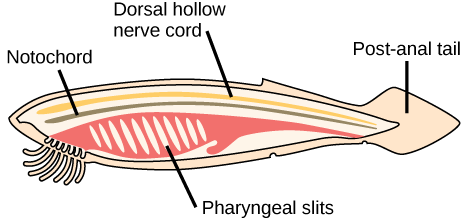
Defining characteristics of chordates: In chordates, four common features appear at some point during development: a notochord, a dorsal hollow nerve cord, pharyngeal slits, and a post-anal tail.
- a notochord
- a dorsal hollow nerve cord
- pharyngeal slits
- post-anal tail
Notochord
The chordates are named for the notochord: a flexible, rod-shaped structure that is found in the embryonic stage of all chordates and also in the adult stage of some chordate species. It is located between the digestive tube and the nerve cord, providing skeletal support through the length of the body. In some chordates, the notochord acts as the primary axial support of the body throughout the animal's lifetime.
In vertebrates, the notochord is present during embryonic development, at which time it induces the development of the neural tube which serves as a support for the developing embryonic body. The notochord, however, is replaced by the vertebral column (spine) in most adult vertebrates.
Dorsal Hollow Nerve Cord
The dorsal hollow nerve cord derives from ectoderm that rolls into a hollow tube during development. In chordates, it is located dorsally (at the top of the animal) to the notochord. In contrast to the chordates, other animal phyla are characterized by solid nerve cords that are located either ventrally or laterally. The nerve cord found in most chordate embryos develops into the brain and spinal cord, which comprise the central nervous system.
Pharyngeal Slits
Pharyngeal slits are openings in the pharynx (the region just posterior to the mouth) that extend to the outside environment. In organisms that live in aquatic environments, pharyngeal slits allow for the exit of water that enters the mouth during feeding. Some invertebrate chordates use the pharyngeal slits to filter food out of the water that enters the mouth. In vertebrate fishes, the pharyngeal slits develop into gill arches, the bony or cartilaginous gill supports.
In most terrestrial animals, including mammals and birds, pharyngeal slits are present only during embryonic development. In these animals, the pharyngeal slits develop into the jaw and inner ear bones.
Post-anal Tail
The post-anal tail is a posterior elongation of the body, extending beyond the anus. The tail contains skeletal elements and muscles, which provide a source of locomotion in aquatic species. In some terrestrial vertebrates, the tail also helps with balance, courting, and signaling when danger is near. In humans and other apes, the post-anal tail is present during embryonic development, but is vestigial as an adult.
Chordates and the Evolution of Vertebrates
Chordata contains two subphylums of invertebrates: Urochordata (tunicates) and Cephalochordata (lancelets).
Learning Objectives
Describe the features and phylogenetic history of lancelets and urochordata
Key Takeaways
Key Points
- Urochordata (tunicates) and Cephalochordata (lancelets) are invertebrates because they lack a backone.
- Larval tunicates (Urochordata) posses all four structures that classify chordates, but adult tunicates retain only pharyngeal slits.
- Larval tunicates swim for a few days after hatching, then attach to a marine surface and undergo metamorphosis into the sessile adult form.
- Lancelets (Cephalochordata) are marine organisms that possess all features of chordates; they are named Cephalochordata because the notochord extends into the head.
- Lancelets may be the closest-living relatives to vertebrates.
Key Terms
- Urochordata: a taxonomic subphylum within the phylum Chordata: the tunicates or sea squirts
- Cephalochordata: a taxonomic subphylum within the phylum Chordata: the lancelets
- sessile: permanently attached to a substrate; not free to move about; "an attached oyster"
Chordates and the Evolution of Vertebrates
The most familiar group of chordates is the vertebrates. However, in addition to the subphylum Vertebrata, the phylum Chordata also contains two subphylums of invertebrates: Urochordata and Cephalochordata. Members of these groups also possess the four distinctive features of chordates at some point during their development: a notochord, a dorsal hollow nerve cord, pharyngeal slits, and a post-anal tail. Unlike vertebrates, urochordates and cephalochordates never develop a bony backbone.
Urochordata
Members of Urochordata are also known as tunicates. The name tunicate derives from the cellulose-like carbohydrate material, called the tunic, which covers the outer body of tunicates. Although tunicates are classified as chordates, only the larval form possesses all four common structures. Adults only maintain pharyngeal slits and lack a notochord, a dorsal hollow nerve cord, and a post-anal tail.

Urochordates: (a) This photograph shows a colony of the tunicate Botrylloides violaceus. (b) The larval stage of the tunicate possesses all of the features characteristic of chordates: a notochord, a dorsal hollow nerve cord, pharyngeal slits, and a post-anal tail. (c) In the adult stage, the notochord, nerve cord, and tail disappear.
Most tunicates are hermaphrodites. Tunicate larvae hatch from eggs inside the adult tunicate's body. After hatching, a tunicate larva swims for a few days until it finds a suitable surface on which it can attach, usually in a dark or shaded location. It then attaches via the head to the surface and undergoes metamorphosis into the adult form, at which point the notochord, nerve cord, and tail disappear.
Most tunicates live a sessile existence on the ocean floor and are suspension feeders. The primary foods of tunicates are plankton and detritus. Seawater enters the tunicate's body through its incurrent siphon. Suspended material is filtered out of this water by a mucous net (pharyngeal slits) and is passed into the intestine via the action of cilia. The anus empties into the excurrent siphon, which expels wastes and water. Tunicates are found in shallow ocean waters around the world.
Cephalochordata
Members of Cephalochordata possess a notochord, dorsal hollow nerve cord, pharyngeal slits, and a post-anal tail in the adult stage. They do not have a true brain, but the notochord extends into the head, which gives the subphylum its name ( "cephalo" is Greek for head). Extinct members of this subphylum include Pikaia, which is the oldest known cephalochordate. Pikaia fossils were recovered from the Burgess shales of Canada and dated to the middle of the Cambrian age, making them more than 500 million years old.
Extant members of Cephalochordata are the lancelets, named for their blade-like shape. Lancelets are only a few centimeters long and are usually found buried in sand at the bottom of warm temperate and tropical seas. Like tunicates, they are suspension feeders. With notochord and paired muscle blocks, the lancelet and Pikaia may belong to the chordate group of animals from which the vertebrates have descended.
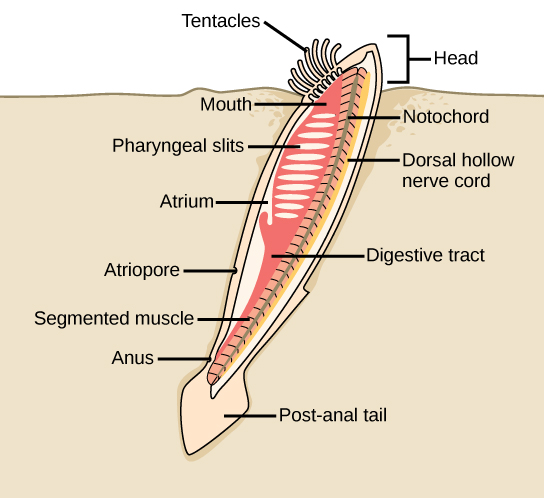
Cephalochrodates: The lancelet, like all cephalochordates, has a head. Adult lancelets retain the four key features of chordates: a notochord, a dorsal hollow nerve cord, pharyngeal slits, and a post-anal tail. Water from the mouth enters the pharyngeal slits, which filter out food particles. The filtered water then collects in the atrium and exits through the atriopore.
The Evolution of Craniata and Vertebrata
Both genomic and fossil evidence suggests that vertebrates evolved from craniates, which evolved from invertebrate chordates.
Learning Objectives
Explain how genomics informs scientists about chordate evolution
Key Takeaways
Key Points
- The clade Craniata includes animals that have a cranium: a bony, cartilaginous, or fibrous structure that surrounds the brain, jaw, and facial bones.
- Members of Craniata include the vertebrates and hagfish.
- Genomic evidence suggests that vertebrates diverged from cephalochordates (lancelets), which had previously diverged from urochordates (tunicates).
- Fossil evidence suggests that most vertebrate diversity originated in the Cambrian explosion 540 million years ago.
- Two whole- genome duplications occurred in early vertebrate history.
Key Terms
- cranium: the part of the skull enclosing the brain, the braincase
- genomics: the study of the complete genome of an organism
- Cambrian explosion: the relatively rapid appearance (over a period of many millions of years), around 530 million years ago, of most major animal phyla as demonstrated in the fossil record
Craniata and Vertebrata
The clade Craniata is a subdivision of Chordata. Members of Craniata posses a cranium, which is a bony, cartilaginous, or fibrous structure surrounding the brain, jaw, and facial bones. The clade Craniata includes all vertebrates and the hagfishes (Myxini), which have a cranium but lack a backbone. Hagfish are the only known living animals that have a skull, but not a vertebral column.
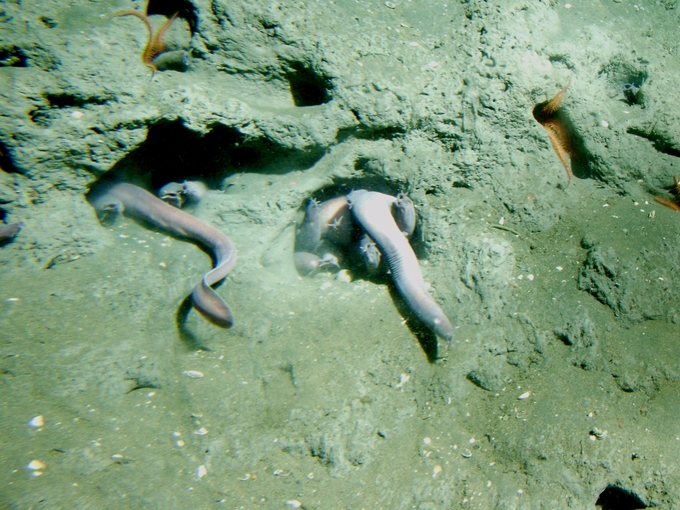
Hagfish: Although it lacks a backbone, the hagfish is a member of the Craniata clade because it possesses a bony skull.
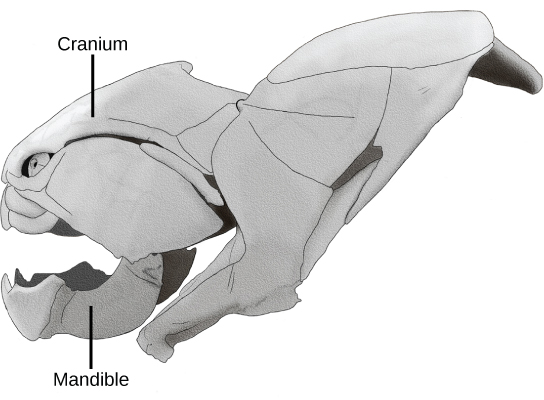
Clade Craniata: Craniata, including this fish (Dunkleosteus), are characterized by the presence of a cranium, mandible, and other facial bones.
Vertebrates are members of the subphylum Vertebrata, the clade Craniata, and the phylum Chordata. Vertebrates display the four characteristic features of chordates, but they are named for the vertebral column composed of a series of bony vertebrae joined together as a backbone. In adult vertebrates, the vertebral column replaces the embryonic notochord.
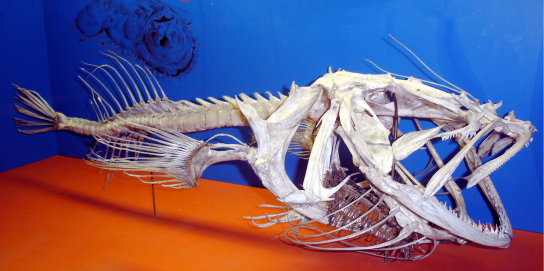
Vertebrates: Vertebrata are characterized by the presence of a backbone, such as the one that runs through the middle of this fish. All vertebrates are in the Craniata clade and have a cranium.
Vertebrate Evolution
In the phylum Chordata, the closest relatives of the vertebrates are the invertebrate chordates. Based on the molecular analysis of vertebrate and invertebrate genomes (genomics), scientists can determine the evolutionary history of different phylogenetic groups.
According to these genomic analyses, vertebrates appear to be more closely related to the lancelets (cephalochordates) than to the tunicates (urochordates). This suggests that the cephalochordates first diverged from urochordates, and that vertebrates subsequently diverged from the cephalochordates. This hypothesis is further supported by the fossil of a 530 million-year-old organism with a brain and eyes like a vertebrate, but without the skull found in a craniate. A comparison of the genomes of a lancelet, tunicate, lamprey, fish, chicken, and human confirmed that two whole-genome duplications occurred in the early history of the Vertebrata subphylum.
Both fossil and genomic evidence suggests that vertebrates arose during the Cambrian explosion.The Cambrian explosion was the relatively brief span of time during the Cambrian period during which many animal groups appeared and rapidly diversified. Most modern animal phyla originated during the Cambrian explosion.
Characteristics of Vertebrates
Vertebrata is a subphlyum of Chordata that is further defined by their bony backbone.
Learning Objectives
Identify the defining characteristics of vertebrates
Key Takeaways
Key Points
- As chordates, vertebrates have the same common features: a notochord, a dorsal hollow nerve cord, pharyngeal slits, and a post-anal tail.
- Vertebrates are further differentiated from chordates by their vertebral column, which forms when their notochord develops into the column of bony vertebrae separated by discs.
- Vertebrates are the only chordates that have a brain as part of their central nervous system.
Key Terms
- vertebral column: the series of vertebrae that protect the spinal cord; the spinal column
- chordate: a member of the phylum Chordata; numerous animals having a notochord at some stage of their development; in vertebrates this develops into the spine
- notochord: a flexible rodlike structure that forms the main support of the body in the lowest chordates; a primitive spine
Characteristics of Vertebrates
Vertebrates are members of the subphylum Vertebrata, under the phylum Chordata and under the kingdom Animalia. Animals that possess bilateral symmetry can be divided into two groups, protostomes and deuterostomes, based on their patterns of embryonic development. The deuterostomes, whose name translates as "second mouth," consist of two phyla: Chordata and Echinodermata. Echinoderms are invertebrate marine animals that have pentaradial symmetry and a spiny body covering; the phylum includes sea stars, sea urchins, and sea cucumbers. The phylum Chordata contains two groups of invertebrate chordates, but the most conspicuous and familiar members of Chordata are the vertebrates.
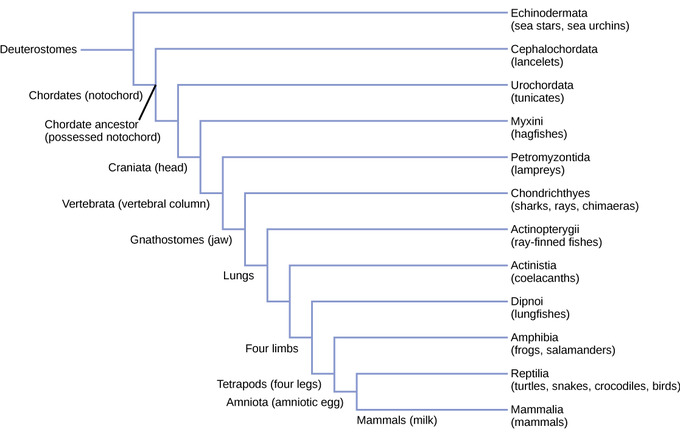
Phylum chordata: All chordates are deuterostomes, possessing a notochord. Vertebrates are differentiated by having a vertebral column.
As chordates, all vertebrates have a similar anatomy and morphology with the same qualifying characteristics: a notochord, a dorsal hollow nerve cord, pharyngeal slits, and a post-anal tail. However, the subphylum Vertebrata is distinguished from the phylum Chordata by the development of the notochord into a bony backbone. Vertebrates include the amphibians, reptiles, mammals, and birds, as well as the jawless fishes, bony fishes, sharks, and rays.
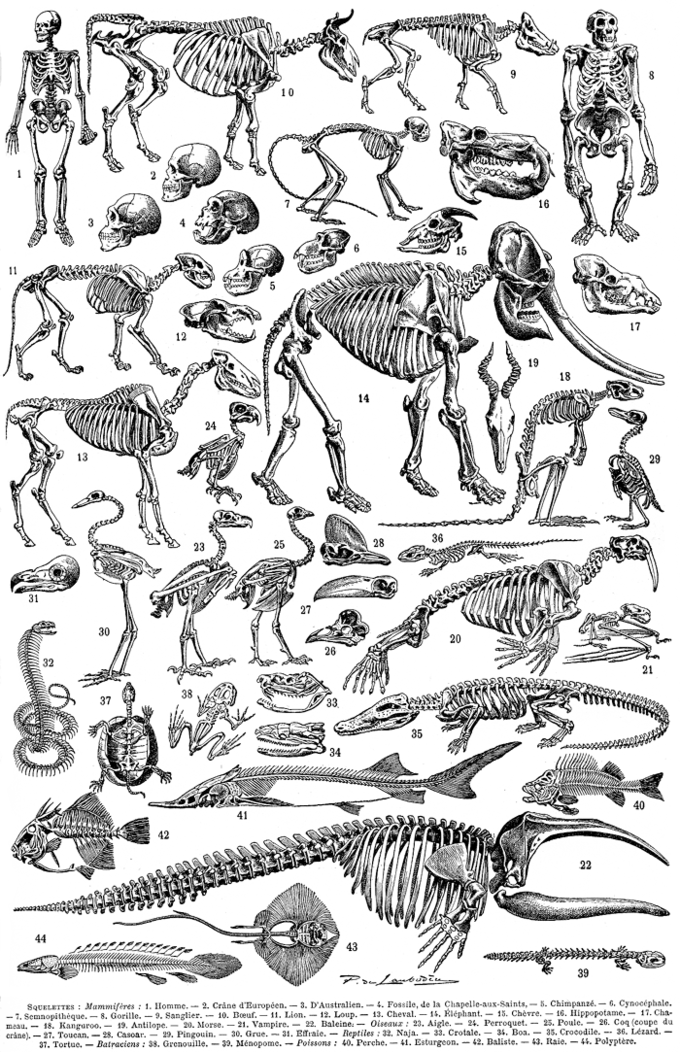
Diversity of vertebrates: animals with backbones: The subphylum Vertebrata contains all animals that possess backbones, gills, and a central nervous system in at least one phase of development. Vertebrates include amphibians, reptiles, mammals, and birds, as well as the jawless fishes, bony fishes, sharks, and rays.
More than 64,000 species of vertebrates have been described, but the extant vertebrate species represent only a small portion of all the vertebrates that have existed. Vertebrates range in size from the frog species Paedophryne amauensis (as small as 7.7 mm (0.3 inch)) to the blue whale (as large as 33 m (110 ft)). Vertebrates comprise about 4 percent of all described animal species; the remainder are invertebrates, which lack backbones.
Anatomy and Morphology
All vertebrates are built along the basic chordate body plan: a stiff rod running through the length of the animal (vertebral column), with a hollow tube of nervous tissue (the spinal cord) above it and the gastrointestinal tract below. In all vertebrates, there is a mouth at anterior end of the animal and an anus before the posterior end of the body. There is a tail posterior to the anus during at least one phase of the animal's development.
The Vertebral Column
Vertebrates are defined by the presence of the vertebral column. In vertebrates, the notochord develops into the vertebral column or spine: a series of bony vertebrae each separated by mobile discs. These vertebrae are always found on the dorsal side of the animal. However, a few vertebrates have secondarily lost their vertebrae and, instead, retain the notochord into adulthood (e.g., the sturgeon fish).

Vertebral column: A fossilized skeleton of the dinosaur Diplodocus carnegii shows an extreme example of the backbone that characterizes vertebrates.
Central Nervous System
Vertebrates are also the only members of Chordata to possess a brain. In chordates, the central nervous system is based on a hollow nerve tube that runs dorsal to the notochord along the length of the animal. In vertebrates, the anterior end of the nerve tube expands and differentiates into three brain vesicles.
Vertebrate Classification
Vertebrates are the largest group of chordates, with more than 62,000 living species. Vertebrates are grouped based on anatomical and physiological traits. The traditional groups include Agnatha, Chondrichthyes, Osteichthyes, Amphibia, Reptilia, Aves, and Mammalia.
Animals that possess jaws are known as gnathostomes, meaning "jawed mouth." Gnathostomes include fishes and tetrapods (amphibians, reptiles, birds, and mammals). Tetrapods can be further divided into two groups: amphibians and amniotes. Amniotes are animals whose eggs are adapted for terrestrial living; this group includes mammals, reptiles, and birds. Amniotic embryos, developing in either an externally-shelled egg or an egg carried by the female, are provided with a water-retaining environment and are protected by amniotic membranes.
Licenses and Attributions
CC licensed content, Shared previously
- Curation and Revision. Provided by: Boundless.com. License: CC BY-SA: Attribution-ShareAlike
CC licensed content, Specific attribution
- notochord. Provided by: Wiktionary. License: CC BY-SA: Attribution-ShareAlike
- OpenStax College, Biology. October 17, 2013. Provided by: OpenStax CNX. Located at: https://openstax.org/books/biology/pages/29-1-chordates. License: CC BY: Attribution
- pharyngeal slit. Provided by: Wikipedia. License: CC BY-SA: Attribution-ShareAlike
- nerve cord. Provided by: Wiktionary. License: CC BY-SA: Attribution-ShareAlike
- OpenStax College, Chordates. October 17, 2013. Provided by: OpenStax CNX. Located at: https://cnx.org/resources/ede30e11a0d290ff1130458a2f9e71281ea8990a/Figure_29_01_02.png. License: CC BY: Attribution
- OpenStax College, Biology. October 17, 2013. Provided by: OpenStax CNX. Located at: https://openstax.org/books/biology/pages/29-1-chordates. License: CC BY: Attribution
- Pikaia. Provided by: Wikipedia. License: CC BY-SA: Attribution-ShareAlike
- Cephalochordata. Provided by: Wiktionary. License: CC BY-SA: Attribution-ShareAlike
- sessile. Provided by: Wiktionary. License: CC BY-SA: Attribution-ShareAlike
- Urochordata. Provided by: Wiktionary. License: CC BY-SA: Attribution-ShareAlike
- OpenStax College, Chordates. October 17, 2013. Provided by: OpenStax CNX. Located at: https://cnx.org/resources/ede30e11a0d290ff1130458a2f9e71281ea8990a/Figure_29_01_02.png. License: CC BY: Attribution
- OpenStax College, Chordates. October 17, 2013. Provided by: OpenStax CNX. Located at: https://cnx.org/resources/346cea7ddab37ac8b2a7cad049868bd13a016754/Figure_29_01_03abc.jpg. License: CC BY: Attribution
- OpenStax College, Chordates. October 17, 2013. Provided by: OpenStax CNX. Located at: https://cnx.org/resources/48a5405dee642ad853accc8ecdc489c61567c8f5/Figure_29_01_04.jpg. License: CC BY: Attribution
- OpenStax College, Biology. October 17, 2013. Provided by: OpenStax CNX. Located at: https://openstax.org/books/biology/pages/29-1-chordates. License: CC BY: Attribution
- Chordate genomics. Provided by: Wikipedia. License: CC BY-SA: Attribution-ShareAlike
- genomics. Provided by: Wiktionary. License: CC BY-SA: Attribution-ShareAlike
- cranium. Provided by: Wiktionary. License: CC BY-SA: Attribution-ShareAlike
- Cambrian explosion. Provided by: Wikipedia. License: CC BY-SA: Attribution-ShareAlike
- OpenStax College, Chordates. October 17, 2013. Provided by: OpenStax CNX. Located at: https://cnx.org/resources/ede30e11a0d290ff1130458a2f9e71281ea8990a/Figure_29_01_02.png. License: CC BY: Attribution
- OpenStax College, Chordates. October 17, 2013. Provided by: OpenStax CNX. Located at: https://cnx.org/resources/346cea7ddab37ac8b2a7cad049868bd13a016754/Figure_29_01_03abc.jpg. License: CC BY: Attribution
- OpenStax College, Chordates. October 17, 2013. Provided by: OpenStax CNX. Located at: https://cnx.org/resources/48a5405dee642ad853accc8ecdc489c61567c8f5/Figure_29_01_04.jpg. License: CC BY: Attribution
- Eptatretus stoutii. Provided by: Wikipedia. Located at: https://en.wikipedia.org/wiki/File:Eptatretus_stoutii.jpg. License: CC BY: Attribution
- OpenStax College, Chordates. October 17, 2013. Provided by: OpenStax CNX. Located at: https://cnx.org/resources/031c18aeb3477f9504d4be7a1b8ad2a3a14b09a0/Figure_29_01_05.jpg. License: CC BY: Attribution
- OpenStax College, Chordates. October 17, 2013. Provided by: OpenStax CNX. Located at: https://cnx.org/resources/d17b521ab1fbf91ab397e406e4879af8bfb4339b/Figure_29_01_06.jpg. License: CC BY: Attribution
- vertebral column. Provided by: Wiktionary. License: CC BY-SA: Attribution-ShareAlike
- notochord. Provided by: Wiktionary. License: CC BY-SA: Attribution-ShareAlike
- OpenStax College, Biology. October 17, 2013. Provided by: OpenStax CNX. Located at: https://openstax.org/books/biology/pages/29-introduction. License: CC BY: Attribution
- Vertebrate. Provided by: Wikipedia. License: CC BY-SA: Attribution-ShareAlike
- OpenStax College, Biology. November 18, 2013. Provided by: OpenStax CNX. Located at: https://openstax.org/books/biology/pages/29-1-chordates. License: CC BY: Attribution
- chordate. Provided by: Wiktionary. License: CC BY-SA: Attribution-ShareAlike
- OpenStax College, Chordates. October 17, 2013. Provided by: OpenStax CNX. Located at: https://cnx.org/resources/ede30e11a0d290ff1130458a2f9e71281ea8990a/Figure_29_01_02.png. License: CC BY: Attribution
- OpenStax College, Chordates. October 17, 2013. Provided by: OpenStax CNX. Located at: https://cnx.org/resources/346cea7ddab37ac8b2a7cad049868bd13a016754/Figure_29_01_03abc.jpg. License: CC BY: Attribution
- OpenStax College, Chordates. October 17, 2013. Provided by: OpenStax CNX. Located at: https://cnx.org/resources/48a5405dee642ad853accc8ecdc489c61567c8f5/Figure_29_01_04.jpg. License: CC BY: Attribution
- Eptatretus stoutii. Provided by: Wikipedia. License: CC BY: Attribution
- OpenStax College, Chordates. October 17, 2013. Provided by: OpenStax CNX. Located at: https://cnx.org/resources/031c18aeb3477f9504d4be7a1b8ad2a3a14b09a0/Figure_29_01_05.jpg. License: CC BY: Attribution
- OpenStax College, Chordates. October 17, 2013. Provided by: OpenStax CNX. Located at: https://cnx.org/resources/d17b521ab1fbf91ab397e406e4879af8bfb4339b/Figure_29_01_06.jpg. License: CC BY: Attribution
- Vertebrate. Provided by: Wikipedia. Located at: https://en.wikipedia.org/wiki/Vertebrate. License: Public Domain: No Known Copyright
- OpenStax College, Biology. November 18, 2013. Provided by: OpenStax CNX. Located at: https://openstax.org/books/biology/pages/29-1-chordates. License: CC BY: Attribution
- Squelettes. Provided by: Wikimedia. License: Public Domain: No Known Copyright
atkinsonatted1946.blogspot.com
Source: https://www.coursehero.com/study-guides/boundless-biology/chordates/
0 Response to "Filterfeeding Organs Found in Invertebrate Chordates Living in Aquatic Environments"
Post a Comment